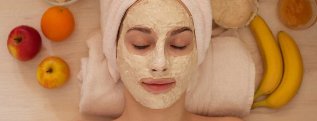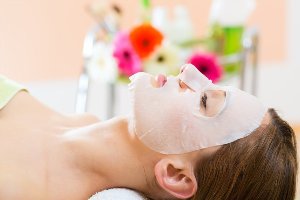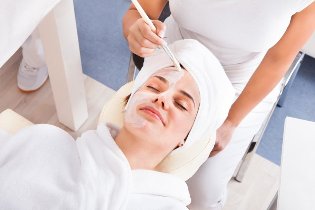
The cosmetics industry is developing a wealth of masks, offering them for both professional salons and home use. However, homemade face masks made from natural ingredients always prefer factory-made options.
After 25 years, girls need to start taking care of their faces and not only wash them off with clean water, but also nourish them with various masks. Otherwise, inadequate care is manifested in early mimic wrinkles and noticeable deterioration of skin condition.
What are the masks?
Face masks are usually categorized according to the effect they produce. There are mask types:
- Nourishing, moisturizing, toning and cleansing - for continuous care and maintenance of the perfect condition of the skin;
- anti-inflammatory, whitening, couperose - this group of masks successfully fights obvious skin blemishes;
- anti-aging, lifting masks - belong to the anti-aging group and help to tighten the skin of the face.
Determine your skin type
Before choosing a face mask, you need to determine your skin type. In classical cosmetology, it is customary to distinguish between skin types:
- bold,
- Dry,
- normal,
- combined.
Because the needs of different skins vary considerably, you should choose a homemade mask depending on which skin type it is.
As a general rule, this is not a problem, as girls are usually attentive to their appearance and skin type can be easily determined even when viewed in the mirror. Sometimes, however, difficulties arise. Therefore, to accurately determine your home skin type, wash your face with regular neutral soap and do not apply any products to it.
After about an hour and a half, place a well-absorbent paper towel firmly on your face. Take a close look at the napkin and evaluate the extent of oily skin:
- If you have sebum on the entire surface of the napkin, it means your skin is not tight at all and you have oily skin type.
- If there are no marks on the napkin, but the skin does not peel off and does not feel tight, then your skin type is normal.
- If there are no traces of grease on the napkin but you feel obvious tightness, your skin is of the dry type.
- If your forehead, nose and chin are marked with bold marks in the middle of the napkin and the skin has left no marks (dry or normal) in the area of application of the faces and temples, such uneven distribution of fat content is combined or mixed. indicates skin type.
Nourishing facials at home

Nourishing masks are needed to make up for the lack of nutrients, vitamins and trace elements in the skin.
Recipe 1Nourishing mask for oily skin (honey)
A simple preparation consisting of 2 teaspoons of honey, 20 drops of lemon juice and 1 tablespoon of low-fat sour cream is ideal for oily skin. Mix all the ingredients in a bowl until smooth, apply the resulting mixture on your face. Hold it for 20 minutes to half an hour, then rinse with warm water.
The mask nourishes the skin, giving it even color, radiance and beauty.
Recipe 2. Nourishing mask for dry skin
To nourish dry skin at home, use the following ingredients:
- 1 egg yolk,
- 2 teaspoons milk
- 1 half tablespoon delicious oatmeal.
Pour the oatmeal with very warm milk, leave to soak slightly (10-15 minutes). Beat the egg yolk with a fork and stir in the flakes. Apply the mass on your face and leave it on for 20 minutes.
This soothing mask that penetrates deep into the pores nourishes dry skin, relieves the feeling of tightness and flaking, and makes it soft and velvety.
Recipe 3. Nourishing mask for normal skin
It is a big misconception that normal facial skin does not need food and care, saturation with vitamins. Nourishing mask for normal skin based on grapes gently and carefully cares for the skin, soothes.
Crush 6-7 grapes of any white variety (or in the last case black), remove all seeds and skins, mix the grape mass with 1 tablespoon of sour cream. Apply the mass on your face, hold for 20-30 minutes, then rinse with warm water. The mask is so nourishing that even irritated skin can heal.
Moisturizing masks at home
Natural moisturizing face masks moisturize the skin. Hydration is most often required in summer and spring, when some moisture is lost from the surface layers of the skin under the influence of ultraviolet radiation and ambient temperature. Even mild dehydration can lead to a decrease in skin elasticity, looseness and the appearance of wrinkles.
Recipe 4. Moisturizing masks for oily skin
The following recipe will help moisturize oily skin. Mix 1 egg white until frothy and mix smoothly with 20 ml of liquid honey. Add 1 heaped tablespoon of chopped oatmeal. Apply the mask on your face, leave it on for 20 minutes. First rinse with warm water, then rinse your face with cold. You can replace the flakes with potatoes or starch to help the pores shrink and nourish the skin.
Recipe 5Moisturizing masks for dry skin
The curd mask perfectly eliminates dryness.
Dry skin needs special hydration, not only in summer and spring, but usually at any time of the year. Mix about 30 g of regular fatty cottage cheese with 2 tablespoons of milk, warmed to body temperature. Bring the mass to a homogeneous texture without lumps. Apply the resulting mask on the skin for 15 minutes. Rinse with warm water.
Recipe 6. Moisturizing masks for normal skin
Use a grapefruit mask to hydrate normal skin. To do this, mix two slices of grapefruit chopped with 1 egg yolk. Apply the mask on the skin for 15 minutes. Then rinse with warm water.
Shaping and cleansing homemade face masks
Cleansing and toning masks have a general strengthening beneficial effect on the skin, activate subcutaneous circulation and cleanse the pores of the face of sebum secretion, giving it a youthful look.
Recipe 7. Toning mask for oily skin
Oily skin is perfectly toned with a white clay mask. To prepare, dissolve 2 tablespoons of white clay in cold boiled water, add 1 egg white, 3-4 drops of lemon juice and 5 ml of honey. The consistency of the homogeneous mass obtained must be similar to that of sour cream. Apply the mask on your face and wait for it to dry completely. Rinse the clay mask with warm water as soon as it is completely dry.
Recipe 8. Cleansing mask for dry skin
Dry skin is visibly improved and cleansed by white clay. To make a home mask, take 1 tablespoon of white clay, twice as much milk and 5 ml of honey. Stir until smooth and apply on face. After 10-15 minutes, rinse the mask and finally use a moisturizer after cleansing.
Recipe 9. Toning mask for normal skin
Normal skin with a lemon peel face mask quickly restores freshness and firmness. Mix 1 yolk and 20 ml of low-fat sour cream, add 1 finely grated peel of lemon. Keep the mask on your face for up to 30 minutes.
Whitening homemade face masks
Many girls dream of getting rid of freckles and usually get facial whitening. At home, whitening face masks help relieve age spots, even age spots.
Recipe 10. The cucumber whitening mask is known to everyone for its good effects. Gently grate a medium-sized cucumber (without seeds) and mix with daily nourishing cream or sour cream. Apply the mass on the face for 20 minutes. Rinse with warm water.
Recipe 11The following whitening face mask proves to be quite liquid. At home, mix the liquid honey and lemon juice in equal volumes. Soak the gauze napkins in the resulting mass, which are then placed on your face. Leave on for 15 minutes, then remove the tissues and gently rinse your face with water.
Anti-aging home face masks
Over time, the skin begins to age - this is an inevitable process. But when the first problematic wrinkles appear, you should not lose your heart, but should incorporate the rejuvenating procedure into your regular skin care. Regular use of anti-aging collagen masks allows you to delay the appearance of new age-related changes on the facial skin and smooth out existing small wrinkles.
Recipe 12. Home aloe vera rejuvenating face mask is very popular. Combine a tablespoon of the juice of this plant with the same amount of nourishing face cream and premium vegetable oil (preferably olive oil). Mix and apply the mask a little warm, keep on your face for 10 minutes.
Recipe 13. In summer, you can make a mask from fresh plantain leaves. The leaves are ground to a crush and mixed in equal parts with honey. If the mixture is too thick as a gelatinous mixture, thin it slightly with water. Keep this bag on your face for at least 15 minutes. Remove with a damp cloth first, then rinse your face with cool water. And there is no need for botulinum toxin.
Lifting masks for the face at home
Fighting sagging facial skin requires constant attention from women over 30. Therefore, when the skin begins to fade, sometimes you need to equip yourself with proven tools to help align the top layer of the epidermis.
Recipe 14. This vitamin anti-aging face mask is made at home from pharmacy ingredients.
Ingredients:
- 1 round tablespoon of pink clay,
- 1 ampoule of vitamin A
- 30 ml unflavoured green tea.

Carefully dilute the dry clay with tea and make the mass homogeneous while stirring continuously. Add vitamin A and apply the entire mixture to the skin. The mask lasts for 25 minutes. Regular use of the recipe restores skin firmness and health.
Rinse this mask with plenty of cold water.
Recipe 15. A natural and effective increase is observed in the egg white. One of the proteins is beaten into a hard foam and mixed with two teaspoons of soaked oatmeal. The exposure time of the mask on the skin is 15 minutes.
The girls say it has a lifting effect: there is a skin tightening.
How to apply the face mask correctly at home
Before applying any mask, you need to cleanse your face of make-up with a gentle makeup remover. A refreshing gel usually completes the makeup removal process, but you can also use additional exfoliation.
Pre-exfoliation of dead cells is desirable for good penetration of all the ingredients of the mask into the facial skin, ensuring maximum effectiveness. The scrub can also be used at home, for example, according to any recipe for a coffee grinder.
Follow the general rules for home cosmetics when applying masks:
- The procedure for applying the mask cannot be performed "at runtime". Set aside all household chores and spend half an hour just for yourself.
- All effective homemade face masks should be prepared (mixed) immediately before use. The remaining weight cannot be stored.
- All ingredients in the mask should be of good quality and ingredients such as sour cream, fruit, kefir, etc. should be included. , they must be fresh.
- Before applying the mask, the face should be cleaned as usual. Owners of oily and combination skin will probably also need a pre-exfoliating skin. After cleansing your skin, open your pores as much as possible, steam over a bath, or make a warm wet compress. This allows for the greatest possible absorption of all the ingredients and the best effect.
- To prevent hair from getting around your face, tie it in a bun and secure it with something.
- Depending on the texture, the mask should be applied with clean hands, a brush, a gauze pad or a cotton pad.
- Most masks should be used not only on the face but also on the neck and décolleté. Exceptions are masks for drying oily skin because the skin in the décolleté area is much drier.
- Apply the home mask along the massage lines, moving from the center of the face to the temple. An exception is the skin directly around the eyes, it is not necessary to use a mask on it.
- Rinse the mask with clean water. It is better not to take it from the tap, but to prepare a jug of boiled water in advance, cooled to body temperature.
- After rinsing off the mask, you do not need to wipe your face, gently wipe off excess moisture with a clean towel. On a wet face, apply a cream suitable for your skin type.
- Do not expect immediate effect from the first procedure. Homemade masks should be repeated regularly, 1-3 times a week. The duration of the course must be at least 3 weeks.
Precautions when using home masks
For girls who are prone to allergies, a test on the wrist or inside the elbow should be done before applying the prepared mask at home. If you show signs of an allergic reaction, take an antihistamine and do not use this product.















































































